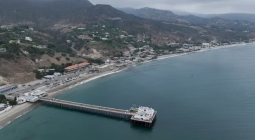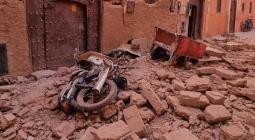Myanmar earthquake: death toll rises to more than 1,000 as search for survivors continues
True scale of disaster yet to emerge and toll expected to rise significantly, with city of Mandalay believed to be especially hard hit
The death toll from a huge earthquake that hit Myanmar has reached more than 1,000, as rescuers dig through the rubble of collapsed buildings in a desperate search for survivors.
The shallow 7.7-magnitude quake struck northwest of the city of Sagaing in central Myanmar in the early afternoon, followed minutes later by a 6.7-magnitude aftershock.
The quake destroyed buildings, downed bridges, and buckled roads across swathes of Myanmar, with severe damage reported in the second biggest city, Mandalay.
The ruling junta said in a statement on Saturday 1,002 people had been confirmed dead and 2,376 injured, with most of the dead in Mandalay. The statement suggested the numbers could still rise, saying “detailed figures are still being collected.”
In neighbouring Thailand, which also felt tremors, Bangkok city authorities said so far six people had been found dead, 26 injured and 47 were still missing, most from a construction site near the capital’s popular Chatuchak market, where a high-rise building collapsed. Earlier statements had said 10 were confirmed dead and about 100 missing.
With communications badly disrupted in Myanmar, the true scale of the disaster has yet to emerge from the isolated military-ruled state, and the toll is expected to rise significantly.
It was the biggest quake to hit Myanmar in over a century, according to US geologists, and the tremors were powerful enough to severely damage buildings across Bangkok, hundreds of kilometres (miles) away from the epicentre.
Rescuers in the Thai capital laboured through the night searching for workers trapped when a 30-storey skyscraper under construction collapsed, reduced in seconds to a pile of rubble and twisted metal by the force of the shaking.
Bangkok city authorities said they will deploy more than 100 engineers to inspect buildings for safety after receiving over 2,000 reports of damage.
While there was no widespread destruction, the shaking brought some dramatic images of rooftop swimming pools sloshing their contents down the side of many of the city’s towering apartment blocks and hotels.
Even hospitals were evacuated, with one woman delivering her baby outdoors after being moved from a hospital building. A surgeon also continued to operate on a patient after evacuating, completing the operation outside, a spokesperson told AFP.
But the worst of the damage was in Myanmar, where four years of civil war sparked by a military coup have ravaged the healthcare and emergency response systems.
Junta chief Min Aung Hlaing issued an exceptionally rare appeal for international aid, indicating the severity of the calamity. Previous military regimes have shunned foreign assistance even after major natural disasters.
A 37-member team from the Chinese province of Yunnan reached the city of Yangon early on Saturday with earthquake detectors, drones and other supplies, the official Xinhua news agency reported.
Russia’s emergencies ministry dispatched two planes carrying 120 rescuers and supplies, according to a report from the Russian state news agency Tass.
India sent a search and rescue team and a medical team as well as provisions, while Malaysia’s foreign ministry said the country would send 50 people on Sunday to help identify and provide aid to the worst-hit areas.
The United Nations allocated $5m to start relief efforts. President Donald Trump said on Friday that the US was going to help with the response, but some experts were concerned about this effort given his administration’s deep cuts in foreign assistance.
The Trump administration’s cuts to the United States Agency for International Development have already forced the United Nations and non-governmental organisation to cut many programmes in Myanmar.
India, France and the European Union offered to provide assistance, while the WHO said it was mobilising to prepare trauma injury supplies.
Chinese President Xi Jinping had spoken to Min Aung Hlaing, the Chinese embassy said, while state media reported he had “expressed deep sorrow” over the destruction and said China was “willing to provide Myanmar the needed assistance to support people in affected areas”.
Myanmar declared a state of emergency across the six worst-affected regions after the quake, and at one major hospital in the capital, Naypyidaw, medics were forced to treat the wounded in the open air.
One official described it as a “mass casualty area”.
Mandalay, a city of more than 1.7 million people, appeared to have been badly hit. Photos showed dozens of buildings reduced to rubble.
A rescue worker from Amarapura, an ancient city and now a township of Mandalay, said the bodies of 30 people had been recovered from collapsed multistorey apartment blocks.
“I have never experienced anything like this before – our town looks like a collapsed city,” he said, estimating that about a fifth of the buildings had been destroyed.
A resident reached by phone told AFP that a hospital and a hotel had been destroyed, and said the city was badly lacking in rescue personnel.
Another witness in Mandalay, who asked not to be named, said eight people had been killed and others were feared to be trapped after a construction building in Pyigyitagon township collapsed.
“The whole of Mandalay city was affected by the earthquake. The rescue teams and hospitals are now overrun. We are managing with the resources we have in the neighbourhood,” they said.
Images published by Khit Thit Media, a news agency based in Myanmar, showed piles of bricks and rubble outside a damaged mosque, also in Mandalay. At least 20 people had died there, it reported, though it was not possible to verify this figure.
A huge queue of buses and lorries lined up at a checkpoint to enter Naypyidaw early on Saturday.
Cover photo: A resident looks on next to a collapsed building in Mandalay, Myanmar, after an earthquake that has killed almost 700 people, with toll expected to rise. Photograph: AFP/Getty Images





